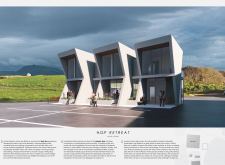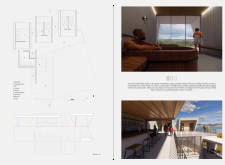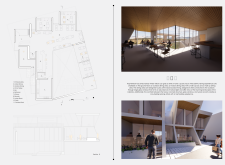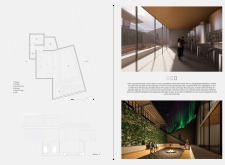5 key facts about this project
### Overview
The H.O.P. Retreat, situated near Lake Mývatn in Iceland, is designed to harmonize with the region's volcanic landscape while offering a modern spa experience rooted in local culture. The project seeks to create a space that fosters relaxation and connection with nature, integrating traditional spa services with innovative architectural solutions.
### Spatial Configuration and Functionality
The architectural design comprises a series of interlinked, angular volumes that establish a visually striking silhouette. This spatial strategy enhances both the aesthetic appeal and functionality, allowing for abundant natural light and expansive views of the surrounding landscape. The layout includes specialized wellness areas, featuring private spa rooms equipped with beer baths, massage spaces, and sufficient shower facilities, facilitating a tranquil environment. Multiple dining locales, both indoors and outdoors, promote social interaction while maximizing scenic vistas. An onsite brewery further enriches the visitor experience by blending leisure with education on the brewing process.
### Material Selection and Sustainability
Materiality is a critical element of the H.O.P. Retreat's design, emphasizing durability and ecological sensitivity in the harsh Icelandic climate. Concrete forms the foundational structure, providing strength and enabling innovative geometric expression. Large glass elements facilitate unobstructed views and natural light penetration, while warm wood accents create inviting interiors, particularly in communal areas like the bar and therapy spaces. Steel components contribute to the modern aesthetic, and the strategic inclusion of greenery, such as plant walls, integrates the building with its natural surroundings, enhancing the overall ambiance. The project employs sustainable practices that reduce energy consumption and optimize comfort throughout the space.

























































